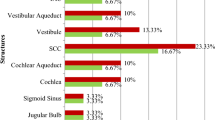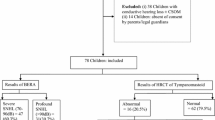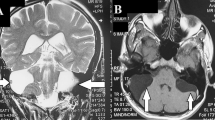Abstract
Computerized tomography (CT) and magnetic resonance (MR) are complementary in the imaging of the labyrinth, the internal auditory canal and the brain in children with sensorineural hearing loss who are being evaluated for cochlear implantation. An accurate anatomical description of the inner ear is essential in the preoperative work up. Computerized tomography visualizes the bony structures, whereas MR can discern soft-tissue components including intra labyrinthine fluid, cerebrospinal fluid (CSF), nerves, and vessels within the IAC. This prospective study was conducted in the Department of Otorhinolaryngology, Head & Neck Surgery, Government Medical College, Srinagar. 40 children in the age group of 1–16 years with unidentified causes of bilateral SNHL were analysed radiologically over the period of 2 years from Dec 2011 to Jan 2014. Each patient underwent MRI and high resolution CT scanning of temporal bone in axial and coronal planes. Out of the 40 patients 22 were males (55 %) and 18 were females (45 %). 30 patients (72.5 %)in our study had normal radiological scans. Five patients (12.5 %) had B/L large vestibular aqueduct and two patients (5 %) had internal auditory canal stenosis with cochlear nerve hypoplasia on CT and MR imaging. Cochlear dysplasia was present in two patients (5 %) and semicircular canal dysplasia was present in one patient (2.5 %) as an isolated finding on HRCT. In addition isolated cochlear nerve hypoplasia was present in one patient (2.5 %). Hyperintense basal ganglia lesion suggestive of kernicterus was present in one patient (2.5 %) and hyperintense posterior parietal and occipital white matter lesions suggestive of congenital CMV infection was present in one patient (2.5 %) on MR imaging. Arachnoid cysts of middle cranial fossa was an incidental finding present in one patient. Radiological abnormalities of the inner ear are not uncommon. Computerized tomography and MRI are important modalities to analyze the inner ear in children with unexplained SNHL. MRI with an extremely small field of view should be used to study possible abnormalities of the vestibulocochlear nerves.











Similar content being viewed by others
References
Brookhouser P (1996) SNHL in children. Pediatr Clin North Am 43:1195–1216
Mehl AL, Thomson V (1998) New born hearing screening the great omission. Pediatrics 101:e4
Jensen J (1969) Malformations of the inner ear in deaf children. Acta Radiol Suppl 286:1–97
Jackler RK, Luxford WM, House WF (1987) Congenital malformation of inner ear: a classification based on embryogenesis. Laryngoscope 97(3, part 2):2
Valvassori GE, Clemis JD (1978) The large vestibular aqueduct syndrome. Larnygoscope 88:723–728
Levenson MJ, Parisier SC, Jacobs M et al (1989) The large vestibular aqueduct syndrome in children. Arch Otolaryngol Head Neck Surg 115:54–58
Jackler RK, De La Cruz A (1989) The large vestibular aqueduct syndrome. Laryngoscope 99:1238–1243
Barr B, Wedenberg E (1965) Perceptive hearing loss in children with respect to genesis and use of hearing aid. Acta Otolaryngol Rhinol 59:462–474
Yuen HY, Ahuja AT, Wong KT, Yue V, Van Hasselt AC (2003) Computed Tomography of common congenital lesions of the temporal bone. Clin Radiol 58:687–693
Jackler RK, Luxford WM, House WF (1987) Congenital malformations of the inner ear: a classification based on embryogenesis. Laryngoscope 97:2–14
Winslow CP, Lepore ML (1997) Imaging quiz case 1. Bilateral agenesis of lateral semicircular canals with hypoplasia of the left internal auditory canal (IAC). Arch Otolaryngol Head Neck Surg 123:1236, 1238–1239
Cho YS, Na DG, Jung JY, Hong SH (2000) Narrow internal auditory canal syndrome: parasagittal reconstruction. J Laryngol Otol 114:392–394
Shelton C, Luxford WM, Tonokawa LL, Lo WWM, House WF (1989) The narrow internal auditory canal in children: a contraindication to cochlear implants. Otolaryngol Head Neck Surg 100:227–231
McClay JE, Tandy R, Grundfast K, Choi S, Vezina G, Zalzal G, Willner A (2002) Major and minor temporal bone abnormalities in children with and without congenital sensorineural hearing loss. Arch Otolaryngol Head Neck Surg 128(6):664–671
Yates JA, Patel PC, Millman B, Gibson WS (1997) Isolated congenital internal auditory canal atresia with normal facial nerve function. Int J Pediatr Otorhinolaryngol 41:1–8
Rothschild MA, Wackym PA, Silvers AR, Som PM (1999) Iso-lated primary unilateral stenosis of the internal auditory canal. Int J Pediatr Otorhinolaryngol 50:219–224
Ferreira T, Shayestehfar B, Lufkin R (2003) Narrow, duplicated internal auditory canal. Neuroradiology 45:308–310
Cho YS, Na DG, Jung JY, Hong SH (2000) Narrow internal auditory canal syndrome: parasaggital reconstruction. J Laryngol Otol 114:392–394
Casselman JW, Offeciers FE, Govaerts PJ, Kuhweide R, Geldof H, Somers T et al (1997) Aplasia and hypoplasia of the vestibulo- cochlear nerve: diagnosis with MR imaging. Radiology 202:773–781
Demir OI, Cakmakci H, Erdag TK, Men S (2005) Narrow duplicated internal auditory canal: radiological findings and review of the literature. Pediatr Radiol 35:1220–1223
Vilain J, Pigeolet Y, Casselman JW (1999) Narrow and vacant internal auditory canal. Acta Otorhinolaryngol Belg 53:67–71
Kesser BW, Raghavan P, Mukherjee S, Carfrae M, Essig G, Hashisaki GT (2010) Imaging case of the month: duplication of the internal auditory canal: radiographic imaging case of the month. Otol Neurotol 31:1352–1353
Baik HW, Yu H, Kim KS, Kim GH (2008) A narrow internal auditory canal with duplication in a patient with congenital sensorineural hearing loss. Korean J Radiol 9:22–25
Rosenberg RA, Cohen NL, Redde L (1987) Radiographic Imaging for the cochlear Implant. Ann Otol Rhinol Laryngol 96:300–304
Wiet RJ, Pyle GM, O’Connor CA et al (1990) Computed tomography: how accurate a predictor for cochlear implantation? Laryngoscope 100:687–692
Pheps PD, Annis JA, Robinson PJ (1990) Imaging for cochlear Implants. Br J Radiol 63:512–516
Pappas et al (1990) High-resolution CT: determination of the cause of pedriatic sensorineural hearing loss. Laryngoscope 100:564–569
Parry DA, Booth T, Roland PS (2005) Adavantages of magnetic resonance imaging over computed tomography in preoperative evaluation of pedriatic cochlear implant candidates. Otol Neurotol 26:976–982
Trimble K, Blaser S, Jmaes AL et al (2007) Computed tomography and/or magnetic resonance imaging before pedriatic cochlear implantation? Developing an investigative strategy. Otol Neurotol 28:317–324
Author information
Authors and Affiliations
Corresponding author
Rights and permissions
About this article
Cite this article
Jallu, A.S., Jehangir, M., Ul Hamid, W. et al. Imaging Evaluation of Pediatric Sensorineural Hearing Loss in Potential Candidates for Cochlear Implantation. Indian J Otolaryngol Head Neck Surg 67, 341–346 (2015). https://doi.org/10.1007/s12070-015-0819-6
Received:
Accepted:
Published:
Issue Date:
DOI: https://doi.org/10.1007/s12070-015-0819-6




